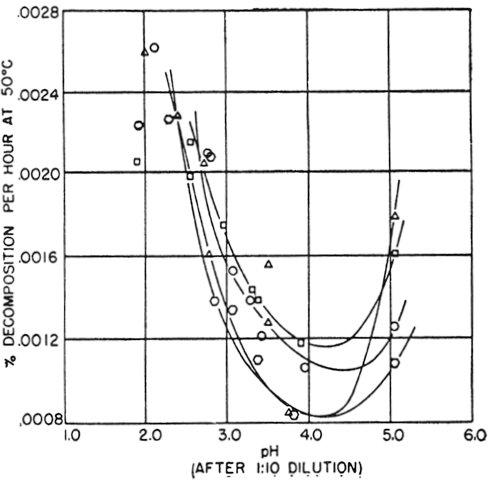Born: April 19, 1907, Dresden, Germany
Died: April 6, 1976, Karlsruhe, Germany
Matriculated: 1928
Locations: Germany, Poland
Probably no other Bauhaus member created more unconventional paintings: thirty-nine scientific diagrams, their abstract structures transformed into colored canvases of a compelling clarity, comprise the magnum opus of Margaret Leiteritz, a soft-spoken graduate from the Dessau years. After graduating, she was only sporadically active as an artist. A trained librarian, she felt her calling in this profession, in this world of structure and order—qualities that also characterize her austere compositions. It was not until her painting Kreuzung am linken Rand (Crossing at the Left Border) was included in the 1968 international touring Bauhaus exhibition and used to adorn the advertising material of the school’s American branch in Chicago that she achieved modest fame.
The daughter of a Jugendstil (Art Nouveau) painter from Dresden, Margaret Camilla Leiteritz was born painting. She lost her father, however, at the young age of eight, and, after graduating from secondary school, she served an apprenticeship at the University of Leipzig library. As a certified librarian, she found a job in the library of the State Academy of Applied Arts (Kunstgewerbebibliothek) in Dresden but also began studying dance at Mary Wigman’s legendary school. The following year she was admitted to the preliminary course (Vorkurs) at the Dessau Bauhaus; her classmate Hans Fischli later described her as a reserved young woman with a Slavic appearance, freckles, and short frizzy hair, with a shy demeanor but highly intelligent and articulate. The next semester, she enrolled in the wall-painting workshop and attended Paul Klee and Wassily Kandinsky’s classes, the latter of whose analytical drawings had a formative influence on her. In 1929, she and Fischli were involved in the exterior and interior painting of two model homes in the Dessau-Törten Housing Estate, and she spent her practical semester (Außensemester) interning in the paint shop of the Kassel State Theater (Staatstheater Kassel). But it was through her submissions to a wallpaper competition, for which she won several awards, that she gained renown at the Bauhaus; subsequently she was selected to serve as the school’s representative to the Rasch wallpaper factory, overseeing production and color choice.

Margaret Leiteritz, original graph with four catenaries, 1949

Margaret Leiteritz, Dienstagskurve, 1966, from the series Gemalte Diagramme
In May 1931, she received Bauhaus Diploma number forty-three; in addition to the director, Ludwig Mies van der Rohe, and the head of the wall-painting workshop, Hinnerk Scheper, Klee and Kandinsky also attested to her attendance of the painting classes. As a result, Leiteritz was one of the few women among the “Junge Bauhausmaler” (“young Bauhaus painters”) as the small group of visual artists was called by the other Bauhäusler. After leaving the Bauhaus and being unemployed for an entire year, in 1933 she reverted to working as a librarian at her former place of employment, the library of the Academy of Applied Arts in Dresden, for which she was not paid for the first year. She held this job until the collapse of Nazi Germany, when, in the last months of the war, after Dresden’s destruction, she and her mother were evacuated to the village of Giersdorf, near Breslau in Silesia (today, Podgórzyn, Poland). Forced to relocate yet again in 1946, she rediscovered her creative talents and began working as a designer in Gebhardshagen in Germany’s Harz region. Between 1950 and 1952, she headed the painting material department (Malstoffkunde) overseeing the library and art collection at the Dr. Kurt Herberts & Co. varnish factory in Wuppertal-Barmen—the very company that, during the war, had temporarily protected and employed former Bauhaus masters Oskar Schlemmer and Georg Muche, who had been placed under a professional ban (Berufsverbot).
This turned out to be nothing more than an artistic interlude: Leiteritz moved to Karlsruhe, where for twenty years, until her retirement in 1972, she worked as a librarian at the Institute for Gas Technology, Combustion Technology, and Water Chemistry at the Karlsruhe Institute of Technology, despite an offer from her former school friend Max Bill to work in the library of his Ulm School of Design. In her role at Karlsruhe, she was surrounded by natural science publications, and inspired by their graphic style she created her Gemalte Diagramme (painted diagrams). Adhering as closely as possible to the black-and-white originals—she even documented the source publication’s full bibliographic reference for each canvas, as if to validate them—she sought harmonious color combinations, with which she translated the rigorous, geometric configurations into flowing, almost metaphysical embodiments of the light sources dealt with at her institute. A fortieth and final canvas remains unfinished, as, shortly before her sixty-ninth birthday, Leiteritz succumbed to incurable cancer. Few of her colleagues in Karlsruhe knew of the creative ambitions of their quiet and withdrawn co-worker.
